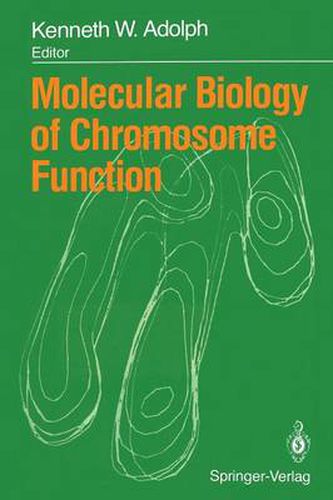Readings Newsletter
Become a Readings Member to make your shopping experience even easier.
Sign in or sign up for free!
You’re not far away from qualifying for FREE standard shipping within Australia
You’ve qualified for FREE standard shipping within Australia
The cart is loading…






This title is printed to order. This book may have been self-published. If so, we cannot guarantee the quality of the content. In the main most books will have gone through the editing process however some may not. We therefore suggest that you be aware of this before ordering this book. If in doubt check either the author or publisher’s details as we are unable to accept any returns unless they are faulty. Please contact us if you have any questions.
Chromosomes have structure, determined by the interactions of proteins with DNA, and chromosomes have functions, in particular, replication of DNA and transcription of messenger RNA. Chromosome structure and function are not separate topics, since chromosome organization pro foundly influences the activity of the genome in replication and transcrip tion. This is especially clear for higher cells, including human cells, in which chromatin fibers are created by the binding of histone proteins to the DNA, and folding of the fibers produces mitotic chromosomes and interphase nuclei. The intricate organization of DNA in higher cells is now recognized as being closely involved with genome activity. Many fundamental results have originated from studies of bacterial and viral systems, which have been systems of choice because of their less complex life cycles. The processes of replication and transcription show differences between the higher and simpler systems (e. g. , different enzymes and protein factors are involved). But the parallels are as striking as the differences in detail. Even for bacteria and viruses, a full understanding of these processes will require integrating the results of molecular biology with those of structural biology and cell biology. Three important subjects are covered in this volume: DNA replication and recombination, gene transcription, and chromosome organization. The sections dealing with replication and transcription examine recent results obtained by applying the techniques of molecular biology and biochemistry. Eukaryotic, prokaryotic, and viral systems are discussed.
$9.00 standard shipping within Australia
FREE standard shipping within Australia for orders over $100.00
Express & International shipping calculated at checkout
This title is printed to order. This book may have been self-published. If so, we cannot guarantee the quality of the content. In the main most books will have gone through the editing process however some may not. We therefore suggest that you be aware of this before ordering this book. If in doubt check either the author or publisher’s details as we are unable to accept any returns unless they are faulty. Please contact us if you have any questions.
Chromosomes have structure, determined by the interactions of proteins with DNA, and chromosomes have functions, in particular, replication of DNA and transcription of messenger RNA. Chromosome structure and function are not separate topics, since chromosome organization pro foundly influences the activity of the genome in replication and transcrip tion. This is especially clear for higher cells, including human cells, in which chromatin fibers are created by the binding of histone proteins to the DNA, and folding of the fibers produces mitotic chromosomes and interphase nuclei. The intricate organization of DNA in higher cells is now recognized as being closely involved with genome activity. Many fundamental results have originated from studies of bacterial and viral systems, which have been systems of choice because of their less complex life cycles. The processes of replication and transcription show differences between the higher and simpler systems (e. g. , different enzymes and protein factors are involved). But the parallels are as striking as the differences in detail. Even for bacteria and viruses, a full understanding of these processes will require integrating the results of molecular biology with those of structural biology and cell biology. Three important subjects are covered in this volume: DNA replication and recombination, gene transcription, and chromosome organization. The sections dealing with replication and transcription examine recent results obtained by applying the techniques of molecular biology and biochemistry. Eukaryotic, prokaryotic, and viral systems are discussed.